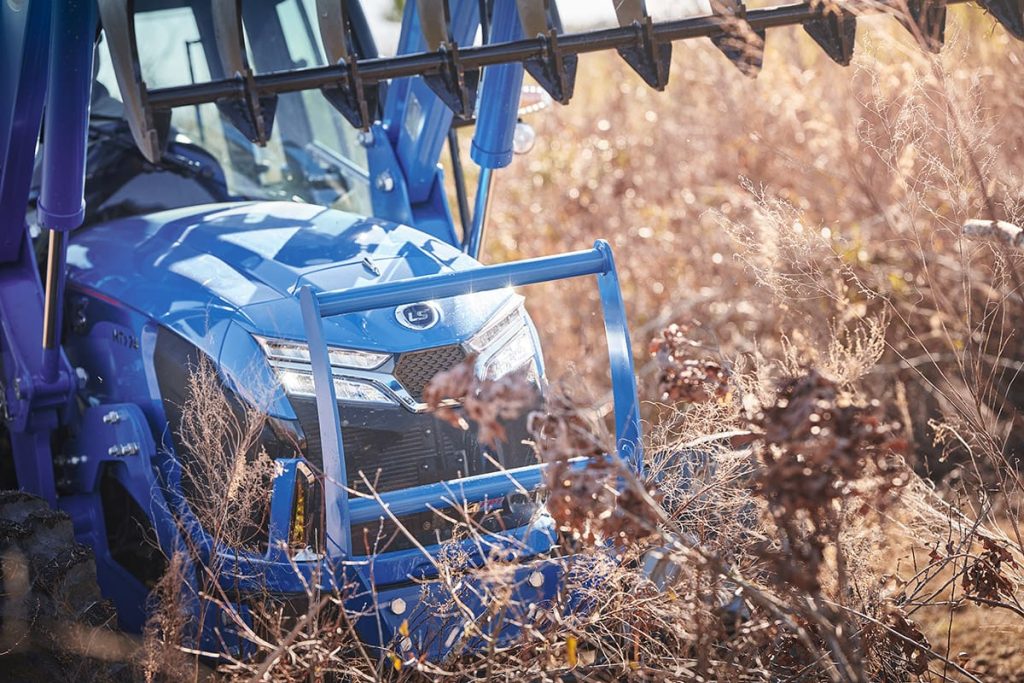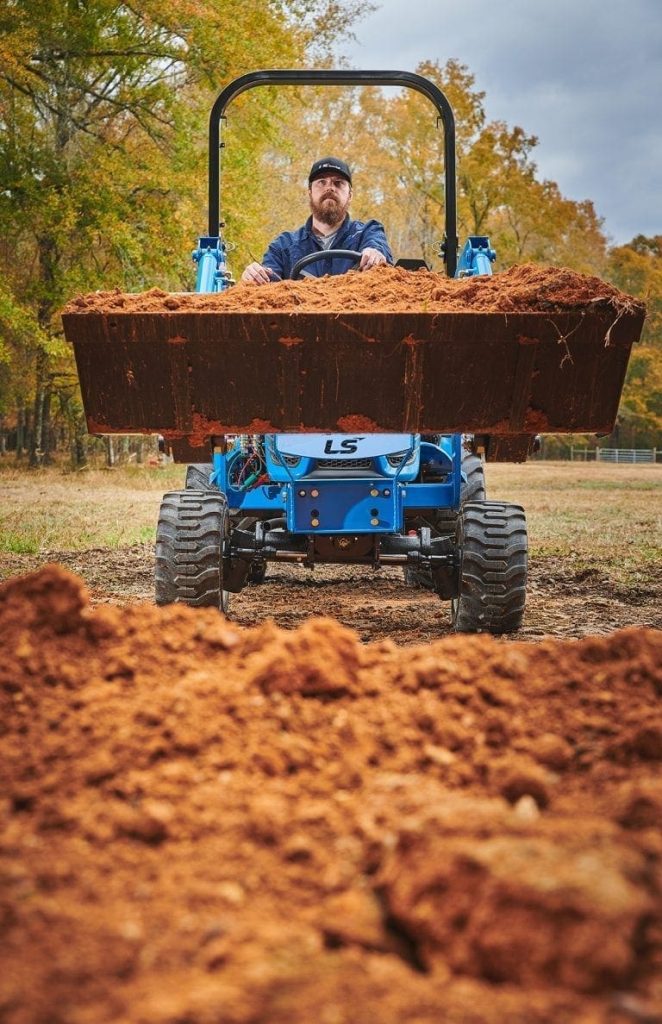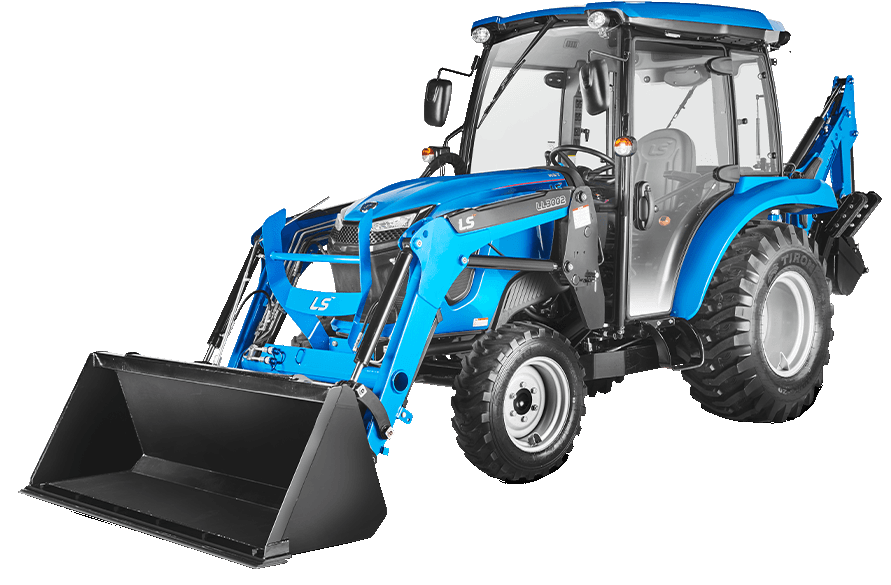Choosing the right tractor for your land management needs can feel like a daunting task, especially with the wide array of models and features available in the market today. Whether you’re tending a small plot or managing sprawling acres, the right tractor size can make all the difference in your agricultural operations.
To help you navigate through the complexities of tractor sizes and capabilities, we’ve sought out expert advice from Shannon Moore, the Eastern Regional Sales Manager for LS Tractor. With years of experience in the tractor industry, Shannon offers valuable insights and practical advice to guide you in selecting the perfect tractor that matches your farming needs.
In this article, we’ll explore the different factors you should consider, including the type of tasks you’re planning to accomplish and the terrain of your land, ensuring you make an informed decision. So, let’s dive into the world of tractors with Shannon and find out the answer to the question…”what size tractor do I need?”
Understanding Tractor Sizes
Tractors are grouped into three general size categories, Shannon explains. From smallest to largest, you have sub-compact tractors, compact tractors, and utility tractors.
“Tractors are grouped into those categories based on a couple of factors,” says Shannon. “How much does it weigh? How big of a footprint does it take up? How much horsepower does it have? How much does it weigh?”
Tractor Horsepower Ratings
“Horsepower, Shannon continues, “is very important to consider, especially depending on which particular attachment you’re going to attach to that tractor. For example, take rotary cutters. If you’re maintaining your property all the time, and you’re never letting anything grow up, then a 25hp subcompact tractor could handle a small 48” rotary cutter; if you’re just maintaining stuff. But if you’re going to be cutting a lot of heavy brush, such as on acreage that hasn’t been maintained in the past, then you’re going to need much more horsepower, because you’re asking that engine to do more. You’re putting it through a lot more stress, and it’s going to take a lot more horsepower to knock down and clean up stuff.”
Tractor Weight
“Weight is also a very important feature when you’re trying to determine what tractor you’re wanting to buy. Because most tractors in America are sold with front end loaders. Now, weight is very important when we talk about front end loaders, because the overall weight of a tractor serves as a counterbalance to the weight being lifted by the front-end loader. This means that heavier tractors can typically lift more because they have more mass to offset the load, reducing the risk of tipping.”

“For example, on a subcompact, we can put a grapple on a subcompact tractor, that works great moving brush and stuff like that, but it doesn’t work real well moving heavy logs. So depending on what you’re doing, you’re going to need a heavier tractor to accommodate that task.”
Tractor Ground Clearance
Shannon continues, “Ground clearance is going to give you the ability to work your way into the woods over stumps, downed trees, and other obstacles without having to clear open ground. That way, you don’t have to take out all that debris in there; you can work around it and just leave it.”
Considerations For Choosing The Right Tractor
Having explored how tractors are sized by horsepower, weight, and ground clearance, you might be wondering how to apply this information to your own needs. It’s important to consider your specific circumstances and the tasks you plan to accomplish with your tractor. To help guide you towards the right size tractor for your farm, garden, or land, let’s delve into some key questions.
What Size Tractor Do I Need For 10 (or 100, or 1,000) Acres?
At first glance, it seems logical to assume that there would be some correlation between how much acreage you’re managing and how much tractor you need. Small tractors are for small properties, and big ones are for larger ones, right?
According to Shannon, “Nope.”
“To say, you know, ‘I’m trying to maintain 10 acres,’ that is such a variable. What exactly are you going to be doing on that 10 acres? Is it wooded? Are you going to just be mowing, or are you cutting and hauling firewood, planting food plots, grading roads, etc.?As a salesperson, I’ve got to ask more questions to see what that tractor is going to be used for in order to help somebody. How much acreage you have is just one small variable.”
What Tractor Accessories Do You Need?
A tractor by itself isn’t really all that useful. You’ll need to pair various attachments with it in order to turn it into a road grading, plot planting, brush cutting wonder-tool. Every attachment has its use, from blowers, to mowers, to grapples, but according to Shannon some attachments are absolutely essential for recreational property managers.
“Hands-down, the most popular attachment we sell is a front end loader,” he stated confidently, “because it then gives you the ability to add a lot of other attachments, like a grapple, for instance. And then you’re going to need to add one other thing, which is a third function kit. And that third function kid is going to be there to give you the ability, as you’re sitting in the operator seat of that tractor and when you’re messing with your loader controls, you’re going to have the ability to lift that grapple up, open the grapple, close the grapple, and then tilt the grapple back and forth.”

“So, the front end loader is a big deal, and it goes on the front of the tractor, but on the back end you’re going to have the three point lift and draw bar, and that’s going to let you hook up popular accessories like a rotary tiller, rotary cutter…even a box blade. There are numerous items that you can put behind that tractor.”
Tractor Sizes
Hopefully, you’re starting to get a feel for what variables you’ll have to consider before purchasing a tractor to make sure you have enough machine for the job. In this section, we’ll take a broad look at subcompact, compact, and utility tractors, and discuss roughly what their capabilities are.
Subcompact Tractors
These bantam-sized tractors are the smallest and least expensive machine we’ll discuss. They typically are powered by 20-25 hp engines, weight about 1,500 lbs, and are capable of handling about 1,000 lbs on a front end loader or three-point lift. Their small footprint means that they excel in tight quarters, and their light weight means that they’re not as likely to tear up the ground. They have low ground clearance, making them less-than-ideal for use in the rough-and-tumble, stump-filled woods, but their low height also means that they can be outfitted with a mid-mount mower.
So who are they for? In the words of a friend of mine, a subcompact tractor, “is the back-saver I wish I’d have bought twenty years ago!” While they’re definitely light-duty machines, they are much more capable than you are at hauling mulch and firewood, mowing acreage, clearing snow from driveways, and moving dirt.
Compact Tractors
“Compact tractors” cover a wider range of size and capabilities than subcompacts. A 25 hp machine might be classified as a compact tractor, but so might a 68 hp model. According to Shannon, a lot of recreational land managers end up with something like LS Tractors MT2 series, which are 30 – 40 hp models capable of handling about 2,500 lbs on the front end loader and about 18,00 lbs on the three-point lift. If you’re handling heavier implements, such as say, no-till drills, Shannon advises stepping up to a MT3, which is on the larger end of the compact spectrum. Compact tractors are generally much more capable than subcompacts at tasks like plot planting, road creation, and more intensive earth moving operation.

Utility Tractors
Utility tractors are the biggest, heaviest, strongest, and most expensive models represented here. They can do everything compact tractors can, plus some. They can handle two to four tons of weight on the front end loader and three point hitch, and weigh in excess of 7,000 lbs. That’s a lot of tractor for food plot planting!
How Much Does A Tractor Cost?
Once you get a feel for how you’ll be using your tractor, what accessories you need to operate, and what size machine will accommodate that, there’s one more question. Cost. How much will a new tractor cost you? That depends, says Shannon.
“When we look at cost as a whole we’ve got to keep in mind what implements you’ll need and everything that we’re possibly going to add to that tractor. Because that’s going to change the dynamics of that question immensely But when we’re looking at just the tractor, You’re going to start at around the $15,000 mark for a subcompact model, and where LS stands right now on the subcompact tractor; you’re in that $15,000 mark. When you go all the way up to the biggest utility tractor that we make, which is a 68 horsepower, you’re going to be in that $52,000 price point. Again, that’s just the tractor. That cost goes up as you start adding the necessary attachments.”
Can I Finance A Tractor And Other Farm Equipment?
Darren Hammonds, the manager of the Montgomery, Alabama branch of First South Farm Credit, gives us some good advice and direction for those who may be in the market for farm equipment loans.
Rates And Terms
One thing that is certain in any situation now when farm equipment loans are being sought- rates are changing on a daily basis. A landowner who is in need of equipment to improve the land whether it’s farm land or hunting land will want to keep a close eye on the current interest rates on loans.
“I expect rates to go up with the current economic situation,” Hammonds said.
He tells us that at present, farm equipment loans are running in the 5% to 6% range.
“Most farm equipment loans are made for three to seven years, and most loans are made for under five years,” he noted.
Used Equipment Rates
A very important point for landowners to consider when looking at farm equipment is that used equipment is a red-hot market, and used machines will not be cheap.
“There’s a 25% down payment, but we do have another option called Farm Credit Express,” Hammonds explained. “It is a point of purchase-type program where people can go directly to approved dealers throughout the state and they can buy used or new equipment and get up to 100% financing. Typically the terms would be as we had discussed earlier. That would be anywhere from three to seven years and rates would still be in the mid-fours or lower fives through that program. The great thing about this program is that it’s kind of like when you go to buy a car. You show up at a car dealership, and you walk in and you get approved. That’s how this would work and typically it takes a few minutes for someone to go through that process”
Some folks might want to know about a private party sale- person to person and if First South Farm Credit can work with that situation. Hammond says the answer is yes.
“Yes, we can certainly do that. That would just be dealing with a party that was not part of the Farm Credit Express System, but it would be a direct loan,” he said.
Hammond advises that landowners who need equipment are not limited to new equipment.
“People are wanting to get pre.def. models (equipment older than emissions control additions) whether they’re using the equipment on their hunting lease or whether they’re using it for full-time farming, but we’re seeing that the used equipment is highly valuable right now,” Hammonds said.
What Kind Of Equipment Can Be Financed?
“We make loans on equipment for any kind of landowner. As long as the equipment can be considered a piece of ag equipment, we can make a loan on it. And that would include all your tractors, implements and things like that,” Hammonds explained. “Most people would not qualify for a loan on an ATV, but this depends on the use of the machine. It might be different for a full-time farmer who uses the ATV as part of the farm operation.”
“The older tractors are bringing in a lot more money than what they have been bringing. So you just have to weigh your different options and see what fits you and your finances. And the important thing to remember about First South is that we can do either one. We can do the new models or the used equipment. It doesn’t matter either way. We will try to format a program around your needs,” he concluded.
Where Are LS Tractors Made?
“Our tractors are manufactured in South Korea,” says Shannon, “and we have three distribution centers in the United States currently.. We’re located in North Carolina, Texas, and California. So our tractors come into those centers, and from there we add things like tires and loaders, but as a whole most assembly is done in South Korea.”
Final Thoughts
As we wrap up our discussion on finding the perfect tractor size, it’s clear that the choice isn’t just about horsepower or features. It’s really about understanding your specific needs and the demands of your land. The right tractor—from a nimble subcompact that’s perfect for small gardens to a powerful utility model designed for heavy farm work—can make your property management tasks much easier and more efficient.
It’s important to remember that the best tractor for you will depend on the tasks at hand. Whether you’re clearing brush, planting food plots, or managing a large farm, each job might require different tractor capabilities and attachments. Shannon Moore has highlighted the importance of considering these factors carefully to avoid overspending or underutilizing your tractor.
So, take your time to consider what you really need before making a purchase. Think about the tasks you’ll be tackling throughout the year, and choose a tractor that won’t just do the job, but will make the job easier. This approach will help you make a smart investment that pays off in productivity and enjoyment on your land.




